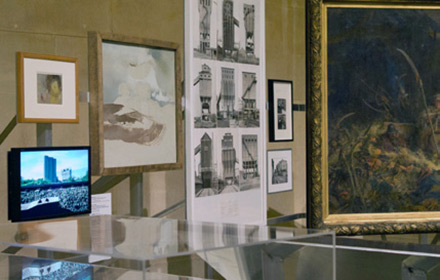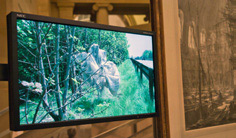NEC Display Solutions Client Installation Leisure & Museums
TATE BRITAIN
CREATING A DISCRETE AND ELEGANT FRAMEWORK TO DISPLAY HIGH QUALITY ART WORKS
For the 2012 commission at Tate Britain, artist Patrick Keiller was invited to animate the space with an exhibition based on his arts practice. Tate selected NEC PA Series displays to present Keiller’s film works, providing elegance and discretion whilst displaying high quality images, colour saturation and resolution with great viewing angles, allowing curatorial flexibility and an enhanced visitor experience.
Part of the Tate gallery network, Tate Britain is situated on Millbank in London and is the oldest art gallery in the network, opening in 1897. Patrick Keiller is an established artist and film maker working for over 30 years. Robinson in Ruins is the third of a series of films centred around a character who observes England, its landscapes, politics and changing economies through the visual image. Keiller was commissioned by Tate for the inaugural Tate Britain Commission.
The Challenge
WE NEEDED TO MATCH KEILLERS’S EXPECTATION WITH A SERIES OF MONITORS THAT COULD MATCH THE QUALITY OF HIS WORK
The gallery space presented many challenges, given its listed status, dimensions, as well as the quantity and variety of other works being exhibited. Jamie Fobert Architects were commissioned by Tate to design a hanging frame conceived specifically for Keiller’s project. The frames are used to create various clusters of artworks within the extensive gallery space that would serve to reflect the artist’s ideas and give curatorial structure to the narrative in a physical and somewhat intuitive way. The moving image element of the exhibit was essential to the presentation. As an artist who works with film, Keiller has a strong sensibility for the quality and resolution which film gives.

“We needed to match Keiller’s expectation with a series of monitors that could match the quality and resolution of his work whilst adhering to the overall curatorial look in relation to the other objects,” explained Aleda Fitzpatrick, time-based media conservator at Tate Britain. She continued “we needed the screens to be hung like framed paintings and to hold the image in that same way.”
The NEC Solution
THEY SEEMED VERY ROBUST AND THIS SOLIDITY WAS NOT A DISTRACTION FROM THE IMAGE
With their existing equipment in mind, as well as the artwork itself, curatorial staff at the Tate were keen to source monitors that would still be as elegant in 10-20 years, that would be timeless to an extent and be durable in function as well as form. Having seen NEC monitors in use in various locations across London including St Paul’s Information Centre, reaffirmed by NEC’s presence at the Integrated Systems Exhibition in The Netherlands, Tate staff were confident that NEC were a brand to investigate.
“We called NEC directly to enquire about what they could offer and within days we had two monitors delivered to test with the artist present that fitted with the given medium specifications. This made it extremely easy to speak in practical terms with the artist and to make very solid decisions about the look of the screen based on the difference in quality,” commented Fitzpatrick.
Aleda Fitzpatrick and Katharine Stout, both responsible for bringing the exhibition to fruition, alongside Patrick Keiller the artist, were able to scrutinise the monitors and were particularly impressed by the wide viewing angles facilitated by the IPS screen and the high quality full HD resolution capability.
“We compromised on the size because of this, given the unusual hanging system of the exhibit and the on the spot decisions made and remade whilst working in installations,” commented Fitzpatrick. “Other factors that lead us to our decision were the input options, the discrete controls, the support structure plate, and the aesthetic longevity of the screen. The overall look was simple, the branding so subtle as to leave on, with display lighting and controls being easily covered and not obtrusive in any case. They seemed very robust and this solidity was not a distraction from the image or exhibit in general.”
The Result

“We were extremely satisfied with the monitors chosen and with the team at NEC and the suppliers they recommended,” commented Fitzpatrick. “The service was prompt and the professional relationships developed strong and reliable. The curators were at liberty to change hanging position without jeopardising the viewing of the image and the artist was free to have control over the final quality of image displayed in relation to the content and other surrounding objects. The hanging system we devised was simple and flexible and the images really stood out from the other works with distinction but without distracting from the overall configuration of artworks.”
Commenting on the monitors after four months in operation, Fitzpatrick said, “they look as fresh as the day we installed them and on the whole their selection and use has contributed greatly to the overall success of the exhibit. Most importantly both the artist and the curator are satisfied and any compromises we made were confirmed to be the right decisions as the installation reached completion.”
In agreement, the artist Patrick Keiller confirmed “we were very pleased with the screens and the assistance we received from NEC when selecting them.”
All images are courtesy of the artist, photography by Jonathan Cooper